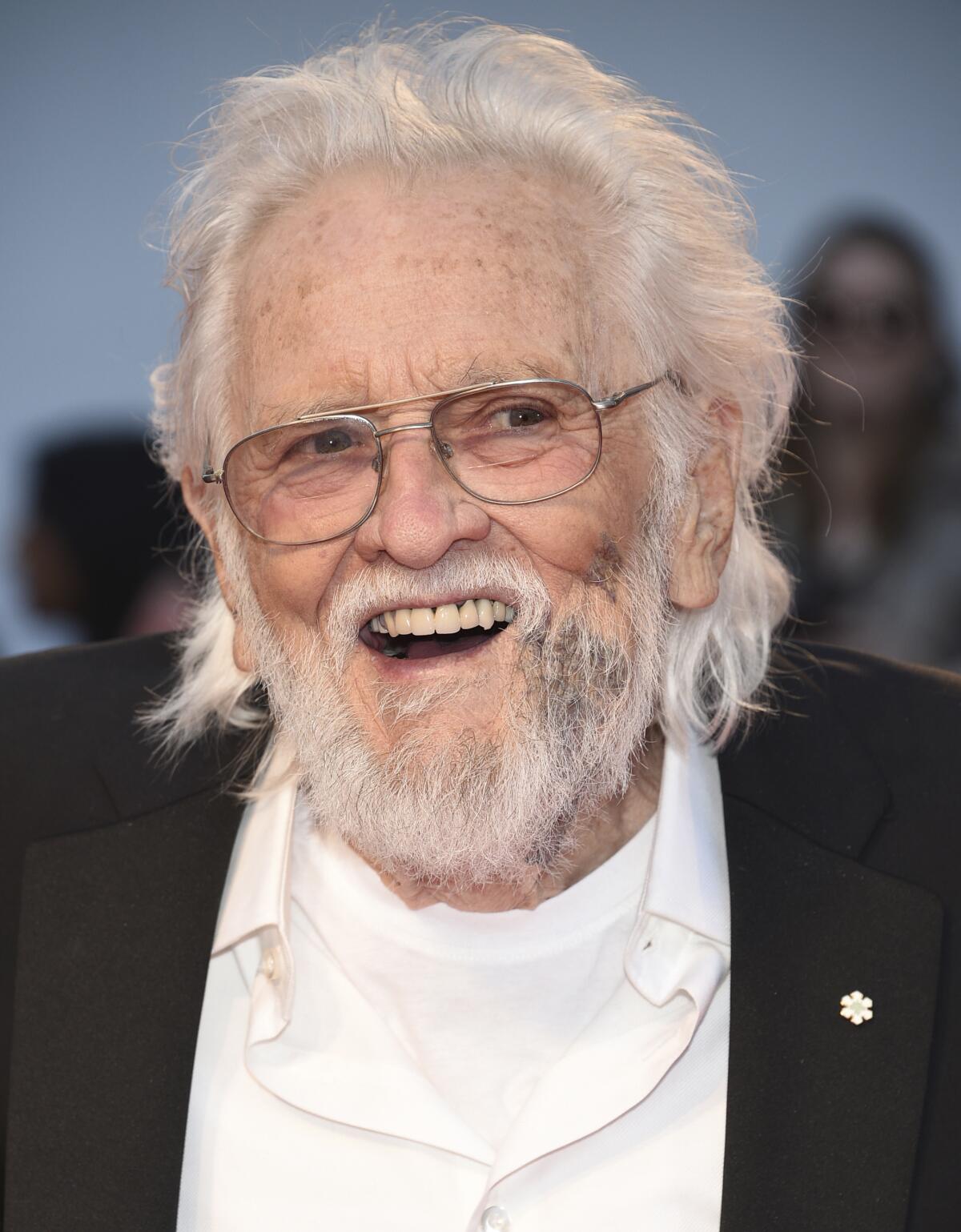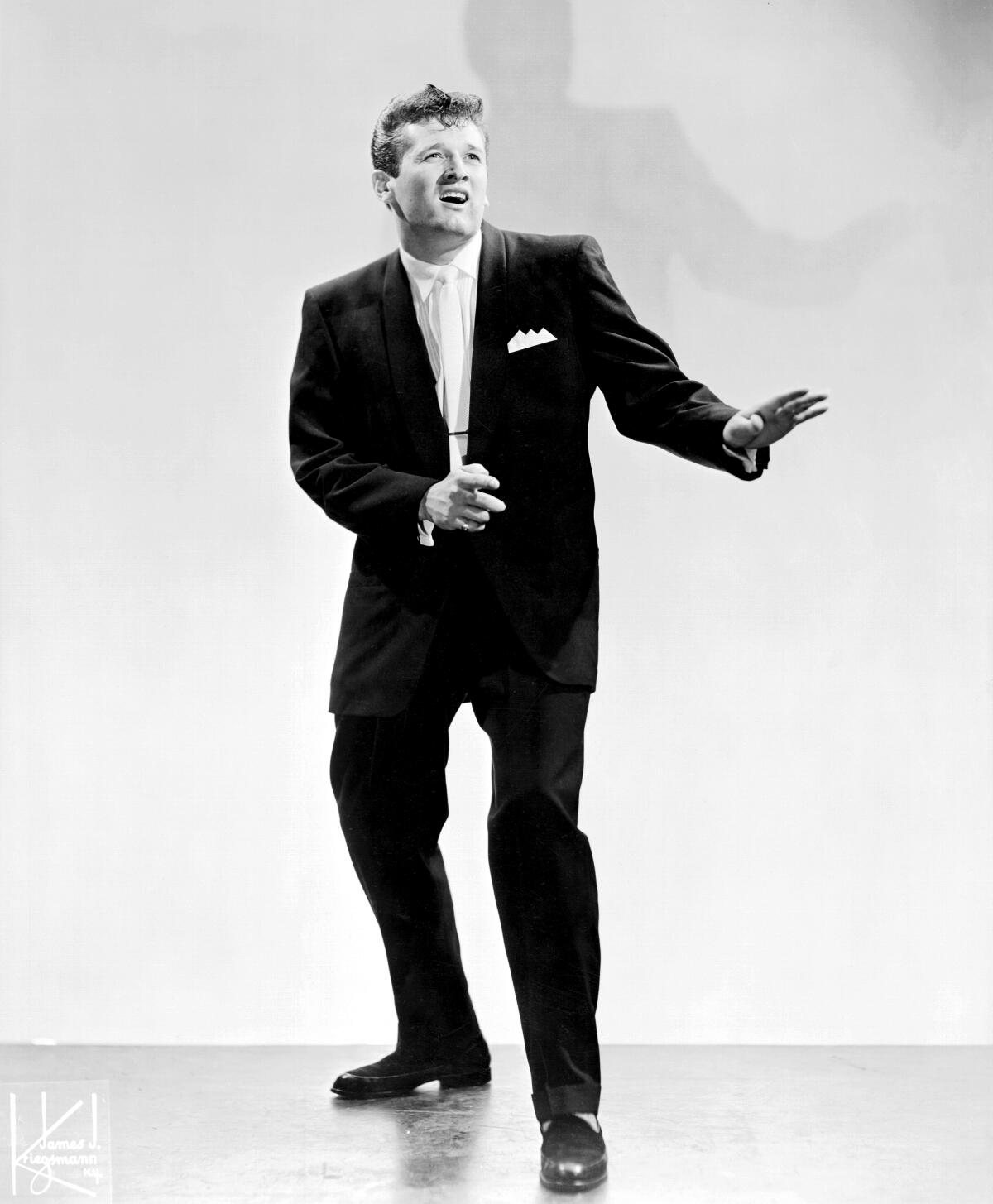Ronnie Hawkins, rockabilly singer and key figure in formation of the Band, dies at 87

- Share via
Ronnie Hawkins, the rowdy rockabilly singer who was instrumental in the formation of the pioneering Americana group the Band, died on Sunday. He was 87.
His wife, Wanda, confirmed his death to the Canadian Press; she didn’t reveal the cause of death but said he’d been in poor health.
The Band’s Robbie Robertson wrote on Facebook, “My heart sank when I heard ‘The Hawk’ just flew into the sunset. The story of the Band began with Ronnie Hawkins. He was our mentor.”
A fiery performer who earned the nickname “Mr. Dynamo” — he also would be known as “The Hawk” and “Rompin’ Ronnie” — Hawkins made his reputation on the road, delivering blues, R&B and rock ’n’ roll covers with grit and gusto. A native of Arkansas, Hawkins cut his teeth playing in bands in the American South during the initial rock ’n’ roll explosion in the late 1950s, but he was closely associated with Canada, immigrating to the country in 1964, long after he became a significant presence on its rock scene with his band the Hawks.
Over the years, numerous musicians cycled through the Hawks, including such notable guitarists Roy Buchanan and Pat Travers, yet they were all overshadowed by the lineup he assembled in the early 1960s, which featured all five future members of the Band: Levon Helm, Robbie Robertson, Rick Danko, Richard Manuel and Garth Hudson. By the mid-’60s, they had parted ways with Hawkins, but their subsequent fame helped elevate Hawkins’ profile. The Band never missed an opportunity to pay tribute to their early benefactor, inviting him to participate in their 1978 farewell film “The Last Waltz” — he sang Bo Diddley’s “Who Do You Love” — with both Helm and Robertson writing generously of him in their respective memoirs, “This Wheel’s on Fire” and “Testimony.”

Ronnie Hawkins was born on Jan. 10, 1935, in Huntsville, Ark. Like Elvis Presley, born two days earlier, Hawkins developed a love for blues and R&B at an early age. Once his family relocated to Fayetteville, Ark., when Ronnie was 9, his father Jasper opened a barbershop. There, Ronnie Hawkins befriended Buddy Hayes, a shoeshine boy who moonlighted in a blues group. Hawkins started to soak up blues, jazz and country. He formed his first bands while still in high school and continued to play music both as a physical education major at the University of Arkansas and during his brief stint in the Army. While he was serving in the military in 1957, he played in a rock ’n’ roll group called the Black Hawks, which was primarily composed of African American musicians, making it one of the few racially integrated bands of the time.
After leaving the Army, Hawkins teamed with guitarist Luke Paulman and started developing his outrageous stage show, filled with backflips and other stunts. Levon Helm, a drummer in the Helena, Ark., area, joined the Hawks while he was still in high school. Fellow musician Conway Twitty told Hawkins that Canadian audiences were hungry for rock ’n’ roll, so he moved the Hawks up north to Toronto, Ontario, in 1958. The next year, Hawkins signed to Roulette Records, cracking the Canadian Top 10 with his first single “Forty Days,” a variation of the Chuck Berry song “Thirty Days.” Its sequel “Mary Lou” gave Hawkins his lone American hit later in 1959.
Robbie Robertson entered the orbit of the Hawks when he was a teenager, contributing two songs to Hawkins’ LP “Mr. Dynamo” and eventually becoming the group’s guitarist in 1960. By the end of 1961, bassist Rick Danko, pianist Richard Manuel and multi-instrumentalist Garth Hudson all had joined the Hawks.
In early 1964, Hawkins’ band left the singer behind so they could perform as Levon and the Hawks; they’d soon be hired by Bob Dylan as his backing group on his electrified 1965 tour. After this mass departure, Hawkins officially moved to Canada and continued to play the kind of clubs he called home. He revived his recording career in 1968 with an eponymous album that found him covering such contemporary songwriters as Dylan and Tim Hardin. More successful was a pair of albums for Cotillion — a second self-titled set, plus “The Hawk” — in the early 1970s, which found him tapping into country-rock.

Hawkins continued to record at a steady pace during the 1970s, a decade that also saw him appear in movies. Bob Dylan hired him to play “Bob Dylan” in his bizarre 1975 film “Renaldo and Clara,” and he performed in “The Last Waltz,” Martin Scorsese’s documentary of the Band’s final concert in 1976. He also joined his friend Kris Kristofferson in Michael Cimino’s western “Heaven’s Gate.”
After hosting a Canadian variety show called “Honky Tonk” early in the 1980s, Hawkins continued to perform and occasionally record; his last album “Still Cruisin’” arrived in 2002. He befriended Bill Clinton before he became governor of Arkansas; Hawkins would later play Clinton’s presidential inauguration in 1993.
During the last decades of his life, he earned several industry honors. He was given the Walt Grealis Special Achievement Award during the 1996 Juno Awards ceremony, and was inducted into the Canadian Music Industry Hall of Fame in 2004. In 2013, he was named an honorary Officer of the Order of Canada.
Hawkins is survived by his wife Wanda and their three children, Ronnie Jr., Robin and Leah, along with four grandchildren.
More to Read
The biggest entertainment stories
Get our big stories about Hollywood, film, television, music, arts, culture and more right in your inbox as soon as they publish.
You may occasionally receive promotional content from the Los Angeles Times.










